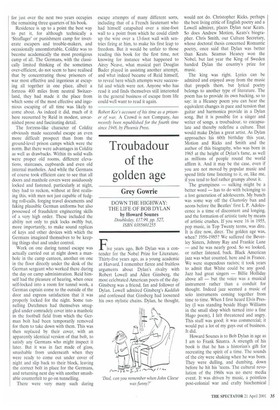The great escapers
Robert Kee
THE COLDITZ STORY by P. R. Reid Cassell Military Paperbacks, £6.99, pp. 222, ISBN 0304358126 You do not need to be a prisoner of war to want from time to time to escape from a life in which you feel inextricably imprisoned. But in normal life, short of suicide, there is no guaranteed way of doing so. In the second world war, suicides in officers' prison camps in Germany were extremely rare. As an officer protected by the Geneva Convention, like the author of this straightforward, riveting book first published nearly 50 years ago, you could as a prisoner of war try to change the entire fabric and condition of your life whenever you felt like it, and failure was no obstacle to trying again, merely bringing you a few weeks solitary rest in the 'cooler'.
Patrick Reid felt like it all the time, only occasionally resting to help other people feeling like it too. Captured on 5 June 1940 at the depressing point in the war when France was collapsing, he planned his first escape from Laufen in Austria with friends over roof-tops for 30 June and, when that had to be abandoned at the last moment, started digging a tunnel from which they escaped on 4 September.
It is hardly spoiling things for new readers to reveal that Reid's vivid description of what happened next ends with their recapture, for it was this that led to him being sent to Colditz, where his residence for just over the next two years occupies the remaining three quarters of his book.
Residence is up to a point the best way to put it, for although technically a `Straflager' or punishment camp for inveterate escapers and trouble-makers, and occasionally uncomfortable. Colditz was to become academically the most prestigious camp of all, The Germans, with the classically limited thinking of the sometimes over-efficient, do not seem to have realised that by concentrating those prisoners of war most effective and ingenious at escaping all together in one place, albeit a fortress 400 miles from neutral Switzerland, they had made it the place from which some of the most effective and ingenious escaping of all time was likely to come about. As indeed it did, much of it here recounted by Reid in modest, unvarnished prose and fascinating detail.
The fortress-like character of Colditz obviously made successful escape an even more difficult prospect than from the ground-level prison camps which were the norm. But there were advantages in Colditz as well as drawbacks. Within its solid walls were proper old rooms, different elevations, staircases, cupboards and even old internal manholes. And while the Germans of course took efficient care to see that all doors and manhole covers were assiduously locked and fastened, particularly at night, they had to reckon, without at first realising this, with men not just capable of fudging roll-calls, forging travel documents and faking plausible German uniforms but also possessed of fraudulent engineering skills of a very high order. These included the ability not only to pick locks swiftly but, more importantly, to make sound replicas of keys and other devices with which the Germans imagined themselves to be keeping things shut and under control.
Work on one daring tunnel escape was actually carried out at night down a manhole in the camp canteen, another on one in the floor directly under the desk of the German sergeant who worked there during the day on camp administration. Reid himself had the pleasure of hearing, when once self-locked into a room for tunnel work, a German captain come to the outside of the door and express satisfaction that it was properly locked for the night. Some tunnelling Dutchmen had themselves smuggled under comradely cover into a manhole in the football field from which the German bolt had been temporarily removed for them to take down with them. This was then replaced by their cover, with an apparently identical version of that bolt, to satisfy any Germans who might inspect it later. But it was in fact made of glass, smashable from underneath when they were ready to come out under cover of night and slip back to their block, leaving the correct bolt in place for the Germans, and returning next day with another smashable counterfeit to go on tunnelling.
There were very many such daring escape attempts of many different sorts, including that of a French lieutenant who had himself catapulted over a nine-foot wall to a point from which he could climb up the wire over a 13-foot wall with sentries firing at him, to make his first leap to freedom. But it would be unfair to those reading this book for the first time, not knowing for instance what happened to Airey Neave, what musical part Douglas Bader played in assisting another attempt, and what indeed became of Reid himself, to reveal here which attempts were successful and which were not. Anyone who has read it and finds themselves still interested in the general business of escape from life could well want to read it again.
Robert Kee's account of his time as a prisoner of war, A Crowd is not Company, has recently been republished for the fourth time since 1948, by Phoenix Press,



































































 Previous page
Previous page